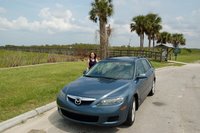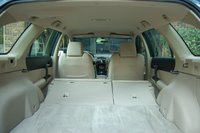Recently, my wife and I concluded our quest to find a replacement vehicle for our venerable-

yet-oh-so-80s 1998 Jeep Cherokee (sport).
The short list leading up to our decision included the 2006 Volvo V50 Estate, the 2006 Mazda6 SportWagon, and a slightly used 2006 BMW 325xi SportWagon. In the end the Mazda6 SportWagon dazzled us with its…exhilarating… plainness…we bought it anyway.
Wagon’s are Back?Estates never really left, they have been and remain (IMHO) the quintessential vehicle of the everyday person. They have simple been in disguise. Think of all the SUVs out there today, and now think of how many of them are actually built on truck chassis. In fact a large majority of them are built like sedans and often times share common platforms with them. We American’s love our SUV’s, not because they are trucks, often they aren’t, we love them because they aren’t estate wagons, but hang on, I think they are.
Whats in a Name;They call it a sport-wagon, and at first, I thought I got it; it’s a square box of mild steel & Aluminum with four little wheels and they don’t want me to feel any worse for being a person who needs such a vehicle than is absolutely necessary. It’s a ‘sport’, in the same spirit as Microsoft Windows is 'professional' or Fox is 'fair and balanced' and the Pontiac Vibe is ‘cool’. We, as a society, have become desensitized to many things, chief among them, due to the rampant proliferation of the word, is ‘sport-x’, ‘sport-y’ on every 5000lb SUV that stumbles out of Detroit’s auto-works. So some of us may indeed be skeptical when we see someone pull-up in the Kia Sportage Sport-model with the optional Sport package. In fact the only car I have owned in the past seven years that did not explicitly assign the word ‘sport’ to some attribute of the car, was a SN-95 Ford Mustang. Instead the Mustang had the ‘performance package’ (you guessed it, leather wrapped steering wheel + fog lamps). If the past 176 words haven’t convinced you, My natural instinct is to consider the use of ‘sport’ in the context of describing an estate wagon to be a overstatement at best or a flat out lie of Plymouth ‘Reliant’ proportions at worst. But when you think about it..
 'Sport' Justification;
'Sport' Justification; It does come standard with the 210BHP 3.0 liter (Ford) Duratec (concerned that they felt a need to say ‘Dura’, would prefer ‘Sportatec’) motor rather than the base 160BHP 2.3L standard on the four door sedan and hatchback models. Net horsepower becomes Effective(ish) horsepower via a six speed ‘Sport’ (not kidding) sequential-automatic slushbox or a slick short-throw 5-speed manual. It weighs 3461lbs (curb) far lighter than Ford’s Freestyle @ 4112lbs (curb) and slightly lighter than Volvo V70 @ 3488lb While not usually considered a plus, the Mazda6’s underlying platform lacks support for an AWD system (at present). In my opinion that’s just as ‘sport’ suggests, somewhat minimalist (although anyone who says the AWD Mitsubishi EVO is not a great sports car, can leave now).
Honestly though, the strongest argument for justifying the sport moniker maybe the leather wrapped steering wheel.
Driving Experiences;It drives like an Americanized sports car, somewhat taunt and composed, that is, until you hit a corner. In all fairness this is by far one of the best handling wagons ever assembled domestically and with a available $300 Mazda speed spring kit you should be able to get into BMW 325xi territory (if they only had a RWD kit).

The main difficulty from a driving perspective is the absence of low-end torque. Like President Bush giving a speech it stutters for a few moments, gains its composure, and finally gets the point across (this is where Pres. Bush and the Mazda6 part ways) with its peek 220 BHP. The Mazda6 (Ford) Duratec motor seems better suited for light truck/SUV duty than for motivational power in a ‘sport’ wagon. That said, once going it really goes, 0-60 in 8.2 seconds according to my informal run with an accelerometer.
Torque Steer? Yes, a bit off the line, however traction control reins it in quickly.
Understeer. For sure…right? Certainly it is impossible to hide the fact that the motor shares its space under the hood with a transversally mounted transmission resulting in a car with 66% of its weight front-biased… but that’s exactly what they almost did (read that twice for effect).
Lock-to-lock; Sometimes I think the only reason my wife liked the Cherokee was because it was all enough to allow the wheels to turn closer to 90 degrees from straight than anything else on the road allowing the driver to make even the most rubbish parking lot maneuvers, successful. Whereas navigating our Mazda6 requires planning and rudimentary geometry skills. It is a brilliant car overall, however intro to geometry should be a perquisite for the educationally-challenged.
When driving in manual-mode the sequential slushbox will allow engine to redline until you shift (a plus, as some cars will upshift automatically at redline). Upshifts feel about right, predictably slow, while downshifts largely depend on the status of the torque converter, current wheel speed, engine rpm and the deltas of those (changes), thus ‘requested’ downshifts may not occur until you are parked in the garage and contemplating a mid-life crises (you were 26 when you parked).
Conclusion;Frankly, it’s obviously the best choice for the discerning buyer, I should know, I bought one.
More Info;http://en.wikipedia.org/wiki/Mazda6http://www.epinions.com/pr-2006_Mazda_6/display_~reviews
 The interior of the Spider is in average condition for a thirty year old Fiat, yeah that bad. Part of my rolling restoration plan is to re-do the interior from the ground up. Literally, starting with the floors. Unfortunately since this requires taking out the seats, consoles, carpet, insulation, and then scraping, begging-off and chemical-bombarding the rubber liner that has become part of the floor...this will need to be done over the course of a 'free' weekend (not many of those on my calendar).
The interior of the Spider is in average condition for a thirty year old Fiat, yeah that bad. Part of my rolling restoration plan is to re-do the interior from the ground up. Literally, starting with the floors. Unfortunately since this requires taking out the seats, consoles, carpet, insulation, and then scraping, begging-off and chemical-bombarding the rubber liner that has become part of the floor...this will need to be done over the course of a 'free' weekend (not many of those on my calendar). Then I will POR-15 the floors, replace the wool insulation with foil-lined foam (home ducting type) and of course the carpet.The OEM carpet was a corn-row type that is, amazingly, common stock at home depot and Lowes. Becca and I picked out a lighter color than the car shipped with. We think it will give the car less of a 'old-dark-dirty' look.
Then I will POR-15 the floors, replace the wool insulation with foil-lined foam (home ducting type) and of course the carpet.The OEM carpet was a corn-row type that is, amazingly, common stock at home depot and Lowes. Becca and I picked out a lighter color than the car shipped with. We think it will give the car less of a 'old-dark-dirty' look.

















